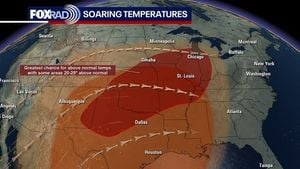On a sweltering August day in Washington, D.C., the city’s rhythms were upended by the sudden arrival of more than 2,200 National Guard troops. Tanks rumbled past Metro stations. Federal agents—some in unmarked vehicles—set up impromptu checkpoints, demanding papers. Houseless encampments were bulldozed, and ICE agents began detaining residents en route to work. For many D.C. locals, this wasn’t just another chapter in the city’s storied political history—it was a dystopian reality that laid bare the fragile autonomy of the nation’s capital.
According to The Amherst Student, the catalyst for this unprecedented federal takeover was a 3 a.m. assault on a 19-year-old DOGE employee by two teenagers. President Donald Trump seized on the incident, declaring that “out-of-control” crime necessitated federal intervention. In mid-August, he announced the federalization of the Metropolitan Police Department and activated the D.C. National Guard, moves he justified as part of a crackdown on lawlessness. Yet, as D.C.’s non-voting congressional delegate Eleanor Holmes Norton pointed out, crime in the city was actually at a 30-year low—a fact widely circulated on social media by residents eager to set the record straight.
The events in Washington were not isolated. On September 2, 2025, Trump announced a similar operation targeting Chicago, with ICE agents and potentially National Guard troops poised to descend on the city. Staging reportedly began at Naval Station Great Lakes, as reported by the Evanston RoundTable, mirroring the tactics employed in D.C. The move followed weeks of heated rhetoric and came just hours after a federal judge ruled that a comparable military deployment in Los Angeles earlier in the summer was illegal under longstanding laws barring military involvement in domestic law enforcement.
In nearby Evanston, Illinois, local officials scrambled to prepare. At a Fourth Ward meeting, Councilmember Jonathan Nieuwsma outlined the city’s updated Welcoming City Ordinance and distributed “Know Your Rights” materials to help residents navigate potential encounters with federal agents. Two pieces of legislation were also introduced: one calling for a ban on federal agents wearing face masks, and another strengthening penalties against impersonating law enforcement. Both measures sailed through the city’s Human Services Committee and were set to be reviewed by the City Council the following week. “The City firmly opposes anonymous enforcement tactics, emphasizing the urgent need for increased transparency and communication between federal law enforcement and communities,” read a public statement from city staff. The goal, officials said, was to foster trust and uphold the rights and dignity of all residents during law enforcement operations.
On the ground, Evanston Police Chief Schenita Stewart issued a general order requiring all local officers to wear uniforms clearly identifying them as Evanston police—a move intended to prevent confusion and build public confidence. Meanwhile, the city terminated its contract with Flock Safety, a private company providing automated license plate readers, after concerns arose about data sharing with federal agencies. The fallout from that decision was swift: Flock Safety threatened legal action to enforce the contract, which was set to run through January 2029, even as city officials expressed confidence in their decision and began searching for a new vendor.
Across state lines in Maryland, Governor Wes Moore found himself at the center of a constitutional tug-of-war. In response to Trump’s threats to send military troops into Baltimore and other cities, Moore publicly asserted his authority as commander-in-chief of the Maryland National Guard. “I am the commander-in-chief of the Maryland National Guard, not him,” Moore told The Baltimore Banner. His pointed words echoed a historic precedent: the last time Baltimore was occupied by the military was in 1861, when Union soldiers fortified Federal Hill to enforce loyalty during the Civil War. Now, 164 years later, Baltimore faced a new kind of threat—one rooted not in open rebellion, but in the politics of federal overreach.
Despite Trump’s claims, Baltimore’s crime statistics told a different story. According to The Baltimore Sun, the city recorded just seven homicides in August 2025, the fewest for that month on record and the lowest total through the first eight months of any year in over half a century. Mayor Brandon Scott highlighted these numbers as evidence that the city was making real progress, even as the President continued to describe Baltimore as “crime-drenched” on social media.
Legal experts remain uncertain about the limits of federal authority in these situations. The Home Rule Act, which grants D.C. a measure of self-governance, restricts emergency executive takeovers of local police to 48 hours, with possible extensions up to 30 days without congressional approval. Yet, the involvement of six Republican governors who sent their own National Guard troops to D.C. has created a murky legal landscape with no clear precedent, leaving many residents and officials anxious about how long the occupation might last.
The broader implications of these federal interventions have not gone unnoticed. Grassroots coalitions in D.C. have organized regular protests, shooed away ICE agents, and established community support networks. But as activists and local leaders argue, these responses are reactive—limited by the city’s lack of full statehood and voting representation in Congress. The D.C. Admission Act (H.R. 51), which would grant the district statehood, has passed the House multiple times but has consistently stalled in the Senate, blocked by conservative opposition.
The debate over federal versus local control is hardly new, but the scale and visibility of recent events have reignited calls for reform. Supporters of D.C. statehood frame the issue as one of basic democratic rights, pointing to the district’s 700,000 residents who pay federal taxes without representation—a grievance famously emblazoned on local license plates. Critics of federal intervention warn that the tactics deployed in D.C. and threatened in cities like Chicago and Baltimore set a dangerous precedent for executive overreach, eroding the checks and balances that underpin American democracy.
Meanwhile, local governments are working to shore up their defenses. Evanston’s push for transparency and accountability in law enforcement, combined with efforts to protect residents’ civil liberties, reflects a growing recognition that the battle over federal power is being fought not just in Congress and the courts, but on city streets and in community centers. In Maryland, Moore’s insistence on gubernatorial authority over the National Guard has become a rallying point for those who believe in the importance of local self-determination.
As the summer of 2025 draws to a close, the struggle for control—over police, over public safety, and over the very definition of democracy—continues to play out in real time. For residents of D.C., Chicago, Baltimore, and beyond, the stakes have never felt more immediate. The outcome will shape not only the future of these cities, but the balance of power between Washington and the states for years to come.






